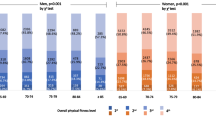Abstract
Context
It is important to develop a method to accurately measure controlled force exertion (CFE).
Objectives
This study aimed to examine the effect of maximum grip strength on CFE measured by a sinusoidal waveform in 81 right-handed young males aged 15–29 years.
Methods
On the basis of grip strength measurements, participants were divided into the following three groups: low (males 20; mean age 19.5 years; standard deviation (SD) = 5.0 years), medium (males 41; mean age 22.8 years; SD = 4.2 years), and high (males 20; mean age 23.7 years; SD = 3.4 years). Participants adjusted the submaximal grip strength of the dominant hand with changes in the demand values that were displayed as a sinusoidal waveform with a frequency of 0.1 Hz on a computer screen. The abovementioned test was performed three times with a 1-min interval after one practice trial. Each trial lasted 40 s. The sum of the differences between the demand value and grip exertion strength value for 25 s was considered as the evaluation parameter.
Results
Controlled force exertion values demonstrated insignificant correlations with age and maximum grip strength in all groups (r = 0.07; r = −0.12; p > 0.05). No significant differences were found between CFE mean scores that was adjusted for age and varying maximum grip strength in the three groups (F = 1.95; p > 0.05).
Conclusions
Based on the sinusoidal waveform display, we inferred that maximum grip strength has little effect on CFE evaluation in young males.


Similar content being viewed by others
References
Ofori E, Samson JM, Sosnoff JJ (2010) Age-related differences in force variability and visual display. Exp Brain Res 203:299–306
Deutsch KM, Newell KM (2001) Age differences in noise and variability of isometric force production. J Exp Child Psychol 80:392–408
Galganski ME, Fuglevand AJ, Enoka RM (1993) Reduced control of motor output in a human hand muscle of elderly subjects during submaximal contractions. J Neurophysio 69:2108–2115
Sosnoff JJ, Newell KM (2008) Age-related loss of adaptability to fast time scales in motor variability. J Gerontol B Psychol Sci Soc Sci 63:344–352
Henatsch H-D, Langer HH (1985) Basic neurophysiology of motor skills in sport: a review. Int J Sports Med 6:2–14
Brown SW, Bennett ED (2002) The role of practice and automaticity in temporal and nontemporal dual-task performance. Psychol Res 66:80–89
Nagasawa Y, Demura S (2002) Development of an apparatus to estimate coordinated exertion of force. Percept Mot Skills 94:899–913
Nagasawa Y, Demura S, Yamaji S et al (2000) Ability to coordinate exertion of force by the dominant hand: comparisons among university students and 65- to 78-year-old men and women. Percept Mot Skills 90:995–1007
Nagasawa Y, Demura S, Kitabayashi T (2004) Concurrent validity of tests to measure the coordinated exertion of force by computerized target-pursuit. Percept Mot Skills 98:551–560
Demura S, Yamaji S (2008) Influence of grip types and intensities on force-decreasing curves and physiological responses during sustained muscle contractions. Sport Sci Health 3:33–40
Noguchi T, Demura S, Aoki H (2009) Superiority of the dominant and nondominant hands in static strength and controlled force exertion. Percept Mot Skills 109:339–346
Demura S, Sato S, Nagasawa Y (2009) Re-examination of useful items for determining hand dominance. Gazz Med Ita Arch Sci Med 168:169–177
Society for Physical Fitness Standards Research in Tokyo Metropolitan University (2000) New physical fitness standards of Japanese people. Fumaido, Tokyo, pp 20–85 (in Japanese)
Walamies M, Turjanmaa V (1993) Assessment of the reproducibility of strength and endurance handgrip parameters using a digital analyzer. Eur J Appl Physiol 67:83–86
Skelton DA, Greig CA, Davies JM et al (1994) Strength, power and related functional ability of healthy people aged 65–89 years. Age Ageing 23:371–377
Nagasawa Y, Demura S, Nakata M (2003) Reliability of a computerized target-pursuit system for measuring coordinated exertion of force. Percept Mot Skills 96:1071–1085
Nagasawa Y, Demura S (2009) Age and sex differences of controlled force exertion measured by a computer-generated sinusoidal target-pursuit system. J Physiol Anthropol 28:199–205
Nagasawa Y, Demura S (2007) Provisional norm and age group differences of controlled force exertion measurements by a computing sinusoidal target-pursuit system in Japanese male adults. Hum Perf Meas 4:1–8
Bemben MG, Massey BH, Bemben DA et al (1996) Isometric intermittent endurance of four muscle groups in men aged 20–74 yr. Med Sci Sports Exerc 28:145–154
Voelcker-Rehage C, Alberts JL (2005) Age-related changes in grasping force modulation. Exp Brain Res 166:61–70
Kawabata H, Demura S, Kitabayashi T (2013) Superior pinch strength in the dominant versus nondominant hand. Sport Sci Health 9:7–11
Bemben MG, Massey BH, Bemben DA et al (1991) Isometric muscle force production as a function of age in healthy 20- to 74-yr-old men. Med Sci Sports Exerc 23:1302–1310
Doyon J, Benali H (2005) Reorganization and plasticity in the adult brain during learning of motor skills. Cur Opin Neurobiol 15:161–167
Cauley JA, Petrini AM, LaPorte RE et al (1987) The decline of grip strength in the menopause: relationship to physical activity, estrogen use and anthropometric factors. J Chronic Dis 40:115–120
Acknowledgments
This study was supported in part by a grant-in-aid for Scientific Research (project number 20500506) to Y. Nagasawa from the Ministry of Education, Science and Culture of Japan.
Conflict of interest
None.
Author information
Authors and Affiliations
Corresponding author
Rights and permissions
About this article
Cite this article
Nagasawa, Y., Demura, S., Takahashi, K. et al. Effect of maximum grip strength on controlled force exertion measured by a computer-generated sinusoidal waveform in young adult males. Sport Sci Health 10, 23–28 (2014). https://doi.org/10.1007/s11332-013-0168-3
Received:
Accepted:
Published:
Issue Date:
DOI: https://doi.org/10.1007/s11332-013-0168-3




